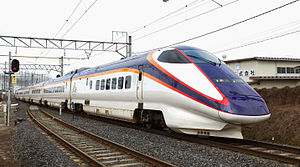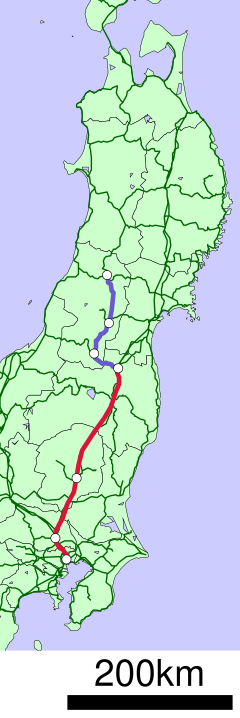Yamagata Shinkansen
| Yamagata Shinkansen | |||
|---|---|---|---|
 E3-1000 series train set L54 on the Yamagata Shinkansen between Kita-yamagata and Yamagata in March 2015 | |||
| Overview | |||
| Native name | 山形新幹線 | ||
| Status | Operational | ||
| Owner | |||
| Locale | Fukushima and Yamagata Prefectures | ||
| Termini | |||
| Stations | 11 | ||
| Color on map | Orange (#f36221) | ||
| Service | |||
| Type | Mini-shinkansen | ||
| Operator(s) | JR East | ||
| Depot(s) | Yamagata | ||
| Rolling stock | |||
| History | |||
| Opened | July 1, 1992 (Tokyo–Yamagata) December 4, 1999 (Yamagata–Shinjō) | ||
| Technical | |||
| Line length | 148.6 km (92.3 mi) | ||
| Number of tracks | Double-track (Single-track in some sections) | ||
| Track gauge | 1,435 mm (4 ft 8+1⁄2 in) standard gauge | ||
| Electrification | Overhead line:
| ||
| Operating speed |
| ||
| Maximum incline | 3.75% | ||
| |||
The Yamagata Shinkansen (山形新幹線) is a Mini-shinkansen route in Japan, operated by East Japan Railway Company (JR East). It provides service between Tokyo and Shinjō in Yamagata Prefecture over the tracks of the Tohoku Shinkansen and the Ōu Main Line.
The term Yamagata Shinkansen refers to the segment that connects Fukushima and Shinjō. Because the shinkansen trains share tracks with local trains running on conventional lines (在来線, zairaisen), it is often referred to as a "mini-shinkansen".
Operations
[edit]
Trains consist of 7-car E3 and E8 series trainsets operating as Tsubasa services. Between Tokyo and Fukushima, some trains run coupled to Yamabiko trains on the Tōhoku Shinkansen. Between Fukushima and Shinjō, the trains run on their own at a maximum speed of 130 km/h (80 mph) and share the line with regular Ōu Main Line trains.[1]
As of July 2012, about 62 million passengers had ridden the line since it opened in July 1992.[2] The fastest trains connect Tokyo and Yamagata stations in two hours and 29 minutes.[2]
Construction of a new approach line at Fukushima Station
[edit]In April 2021, JR East started construction of a new approach line at Fukushima station. Currently, the Yamagata Shinkansen can only enter and exit the Tohoku Shinkansen through platform 14 at Fukushima Station. This current layout requires the Yamagata Shinkansen to cross the north bound tracks to reach the Tokyo bound tracks. This new approach line will pass under the Tohoku Shinkansen, which will allow Yamagata Shinkansen to enter the Tohoku Shinkansen on platform 11 removing the crossing and reducing the gravitude of transport disruption. Construction is expected to finish by the end of fiscal year 2026.[3]
Proposed Ou base tunnel
[edit]Construction of a base tunnel on the Yamagata Shinkansen is proposed, with JR East having undertaken a survey of a planned route from Niwasaka to Sekine, just south of Yonezawa station.[4] 23.1 km (14.4 mi) of the proposed 24.9 km (15.5 mi) line would be in tunnel, mostly to the north of the existing 88 km (55 mi) Fukushima – Yamagata section. To be built on an improved alignment, the tunnel would lower journey times between Fukushima and Yamagata by ~10 min due to a proposed line speed of up to 200 km/h (124 mph).[5]
The tunnel would avoid the Itaya Toge pass through the Ou mountains west of Fukushima. Gradients range from 3.0% to 3.8% and the line reaches an altitude of 548 m (1,798 ft). The curvature and steep grades limit train speeds to 55 km/h (34 mph) or less, and the line is vulnerable to heavy rain and snowfall as well as high winds.[4] Between 2011 and 2017 a total of 410 Yamagata mini-Shinkansen services were either suspended or delayed, and 40% of these incidents occurred on the line over the Itaya Toge pass.[4]
If the ¥150 billion base tunnel is authorised, detailed design would take five years and construction another 15 years.[6] The cost could increase by ¥12 billion if the tunnel were to be built with a cross-section large enough to permit the line to be upgraded to the full Shinkansen Loading gauge.[4]
Station list
[edit]Route map | |||||||||||||||||||||||||||||||||||||||||||||||||||||||||||||||||||||||||||||||||||||||||||||||||||||||||||||||||||||||||||||||||||||||||||||||||||||||||||||||||||||||||||||||||||||||||||||||||||||||||||||||||||||||||||||||||||||||||||||||||||||||||||||||||||||||||||||||||||||||||||||||||||||||||||||||||||||||||||||||||||||||||||||||||||||||||||||||||||||||||||||||||||||||||||||||||||||||||||||||||||||||||||||||||||||||||||||||||||||||||||||||||||||||||||||||||||||||||||||||||||||||||||||||||||||||||||||||||||||||||||||||||||||||||||||||||||||||||||||||||||||||||||||||||||||||||||||||||||||||||||||||||||||||||||||||||||||||||||||||||||||||||||||||||||||||||||||||||||||||||||||||||||||||||||||||||||||||||||||||||||||||||||||||||||||||||||||||||||||||||||||||||||||||||||||||||||||||
|---|---|---|---|---|---|---|---|---|---|---|---|---|---|---|---|---|---|---|---|---|---|---|---|---|---|---|---|---|---|---|---|---|---|---|---|---|---|---|---|---|---|---|---|---|---|---|---|---|---|---|---|---|---|---|---|---|---|---|---|---|---|---|---|---|---|---|---|---|---|---|---|---|---|---|---|---|---|---|---|---|---|---|---|---|---|---|---|---|---|---|---|---|---|---|---|---|---|---|---|---|---|---|---|---|---|---|---|---|---|---|---|---|---|---|---|---|---|---|---|---|---|---|---|---|---|---|---|---|---|---|---|---|---|---|---|---|---|---|---|---|---|---|---|---|---|---|---|---|---|---|---|---|---|---|---|---|---|---|---|---|---|---|---|---|---|---|---|---|---|---|---|---|---|---|---|---|---|---|---|---|---|---|---|---|---|---|---|---|---|---|---|---|---|---|---|---|---|---|---|---|---|---|---|---|---|---|---|---|---|---|---|---|---|---|---|---|---|---|---|---|---|---|---|---|---|---|---|---|---|---|---|---|---|---|---|---|---|---|---|---|---|---|---|---|---|---|---|---|---|---|---|---|---|---|---|---|---|---|---|---|---|---|---|---|---|---|---|---|---|---|---|---|---|---|---|---|---|---|---|---|---|---|---|---|---|---|---|---|---|---|---|---|---|---|---|---|---|---|---|---|---|---|---|---|---|---|---|---|---|---|---|---|---|---|---|---|---|---|---|---|---|---|---|---|---|---|---|---|---|---|---|---|---|---|---|---|---|---|---|---|---|---|---|---|---|---|---|---|---|---|---|---|---|---|---|---|---|---|---|---|---|---|---|---|---|---|---|---|---|---|---|---|---|---|---|---|---|---|---|---|---|---|---|---|---|---|---|---|---|---|---|---|---|---|---|---|---|---|---|---|---|---|---|---|---|---|---|---|---|---|---|---|---|---|---|---|---|---|---|---|---|---|---|---|---|---|---|---|---|---|---|---|---|---|---|---|---|---|---|---|---|---|---|---|---|---|---|---|---|---|---|---|---|---|---|---|---|---|---|---|---|---|---|---|---|---|---|---|---|---|---|---|---|---|---|---|---|---|---|---|---|---|---|---|---|---|---|---|---|---|---|---|---|---|---|---|---|---|---|---|---|---|---|---|---|---|---|---|---|---|---|---|---|---|---|---|---|---|---|---|---|---|---|---|---|---|---|---|---|---|---|---|---|---|---|---|---|---|---|---|---|---|---|---|---|---|---|---|---|---|---|---|---|---|---|---|---|---|---|---|---|---|---|---|---|---|---|---|---|---|---|---|---|---|---|---|---|---|---|---|---|---|---|---|---|---|---|---|---|---|---|---|---|---|---|---|---|---|---|---|---|---|---|---|---|---|---|---|---|---|---|---|---|---|---|---|---|---|---|---|---|---|---|---|---|---|---|---|---|---|---|---|---|---|---|---|---|---|---|---|---|---|---|---|---|---|---|---|---|---|---|---|---|---|---|---|---|---|---|---|---|---|---|---|---|---|---|---|---|---|---|---|---|---|---|---|---|---|---|---|---|---|---|---|---|---|---|---|---|---|---|---|---|---|---|---|---|---|---|---|---|---|---|---|---|---|---|---|---|---|---|---|---|---|---|---|---|---|---|---|---|---|---|---|---|---|---|---|---|---|---|---|---|---|---|---|---|---|---|---|---|---|---|---|---|---|---|---|---|---|---|---|---|---|---|---|---|---|---|---|---|---|---|---|---|---|---|---|---|---|---|---|---|---|---|---|---|---|---|---|---|---|---|---|---|---|---|---|---|---|---|
| |||||||||||||||||||||||||||||||||||||||||||||||||||||||||||||||||||||||||||||||||||||||||||||||||||||||||||||||||||||||||||||||||||||||||||||||||||||||||||||||||||||||||||||||||||||||||||||||||||||||||||||||||||||||||||||||||||||||||||||||||||||||||||||||||||||||||||||||||||||||||||||||||||||||||||||||||||||||||||||||||||||||||||||||||||||||||||||||||||||||||||||||||||||||||||||||||||||||||||||||||||||||||||||||||||||||||||||||||||||||||||||||||||||||||||||||||||||||||||||||||||||||||||||||||||||||||||||||||||||||||||||||||||||||||||||||||||||||||||||||||||||||||||||||||||||||||||||||||||||||||||||||||||||||||||||||||||||||||||||||||||||||||||||||||||||||||||||||||||||||||||||||||||||||||||||||||||||||||||||||||||||||||||||||||||||||||||||||||||||||||||||||||||||||||||||||||||||||
- All stations listed below are located on the Ōu Main Line.
- Beyond Fukushima, trains bound for Tokyo run with Tohoku Shinkansen trains.
| Station | Japanese | Distance (km) | Transfers | Location | ||
|---|---|---|---|---|---|---|
| From Tokyo | From Fukushima | |||||
| Fukushima | 福島 | 272.8 | 0.0 |
|
Fukushima | Fukushima |
| Yonezawa | 米沢 | 312.9 | 40.1 | Yonezawa | Yamagata | |
| Takahata | 高畠 | 322.7 | 49.9 | Takahata, Higashiokitama District | ||
| Akayu | 赤湯 | 328.9 | 56.1 | Nanyō | ||
| Kaminoyama-Onsen | かみのやま温泉 | 347.8 | 75.0 | Kaminoyama | ||
| Yamagata | 山形 | 359.9 | 87.1 | Yamagata | ||
| Tendō | 天童 | 373.2 | 100.4 | Tendō | ||
| Sakurambo-Higashine | さくらんぼ東根 | 380.9 | 108.1 | Higashine | ||
| Murayama | 村山 | 386.3 | 113.5 | Murayama | ||
| Ōishida | 大石田 | 399.7 | 126.9 | Ōishida, Kitamurayama District | ||
| Shinjō | 新庄 | 421.4 | 148.6 | Shinjō | ||
Rolling stock
[edit]As of March 2024, the following types are used on Yamagata Shinkansen services.

- E3-2000 series 7 car sets, since 20 December 2008 (to be replaced by E8 series after 2024)
- E8 series 7-car sets, since 16 March 2024[7]
Former rolling stock
[edit]
- 400 series 7-car sets (originally 6-car sets) withdrawn by 18 April 2010
- E3-1000 series 7-car sets (from 4 December 1999 until 18 March 2024)[8]
Non-revenue-earning-types
[edit]
History
[edit]- 1 July 1992: Tsubasa services start from Tokyo to Yamagata with six-car 400 Series Shinkansen attached to a 200 Series Shinkansen on Tōhoku Shinkansen tracks between Tokyo and Fukushima.
- 1 December 1995: Trains are extended to seven cars.
- 4 December 1999: Line is extended to Shinjō.
- 21 September 2001: Double-decker E4 Series Shinkansen replace the 200 series trains on the Tōhoku Shinkansen.
- 18 March 2007: All cars are made non-smoking.
- 20 December 2008: E3-2000 series trains enter service
- 18 April 2010: 400 series trains cease operations.
- 11 March 2011: All services are suspended due to the Tōhoku earthquake and tsunami.
- 31 March 2011: Partial services resume between Fukushima and Shinjō.
- 12 April 2011: Through-service resumed between Tokyo and Shinjō but at half of previous capacity.[9]
- 13 February 2021: Services suspended north of Nasushiobara Station due to the 2021 Fukushima earthquake.[10]
- 9 June 2022: The line celebrates 30 years of operation. An E3 series trainset will be wrapped in a commemorative livery and will stay in service until November 2022.[11]
- 16 March 2024: Start of service by the E8 Series[7]
References
[edit]- ^ "300km/hのトップランナー" [300 km/h Top Runners]. Japan Railfan Magazine. Vol. 52, no. 612. Japan: Koyusha Co., Ltd. April 2012. p. 14.
- ^ a b "Yamagata Shinkansen Line turns 20". The Japan Times. Japan: The Japan Times Ltd. 3 July 2012. p. 2. Archived from the original on 25 July 2012. Retrieved 30 December 2013.
- ^ "【解説】下り線を"またぐ"運転解消へ 山形新幹線「アプローチ線」工事中 JR福島駅 | TBS NEWS DIG (1ページ)". TBS NEWS DIG (in Japanese). 2023-02-24. Retrieved 2023-05-22.
- ^ a b c d "Yamagata mini-Shinkansen base tunnel proposal makes progress". Railway Gazette International. 7 November 2022. Retrieved 12 November 2022.
- ^ "Yamagata pins hopes on shinkansen tunnel, but faces roadblocks". The Japan Times. 2023-01-23. Retrieved 2023-05-22.
- ^ "A 23 km tunnel planned on Yamagata Shinkansen – Difficult section with heavy snowing - [WTM] Railway & Travel News". 2022-11-14. Retrieved 2023-05-22.
- ^ a b "山形新幹線 25年ぶりの新型車両「E8系」営業運転開始" ["E8 series", begins revenue service, the first new vehicle on the Yamagata Shinkansen in 25 years]. NHK. 16 March 2024. Retrieved 16 March 2024.
- ^ "E3系L53編成が新潟へ" [E3 series set L53 forwarded to Niigata]. Japan Railfan Magazine Online (in Japanese). Japan: Koyusha Co., Ltd. 19 March 2024. Retrieved 19 April 2024.
- ^ NHK, "Yamagata Shinkansen fully resumes operations", 12 April 2011.
- ^ "Tohoku Shinkansen line breaks from the base of utility poles" (in Japanese). TBS News. 14 February 2021. Archived from the original on 14 February 2021. Retrieved 14 February 2021.
- ^ "山形新幹線開業30周年を記念したラッピング車両を運転" [Driving a wrapping vehicle commemorating the 30th anniversary of the opening of the Yamagata Shinkansen]. Japan Railfan Magazine Online (in Japanese). 7 June 2022. Archived from the original on 7 June 2022. Retrieved 8 June 2022.
External links
[edit]- Stations of Yamagata Shinkansen (JR East) (in Japanese)





